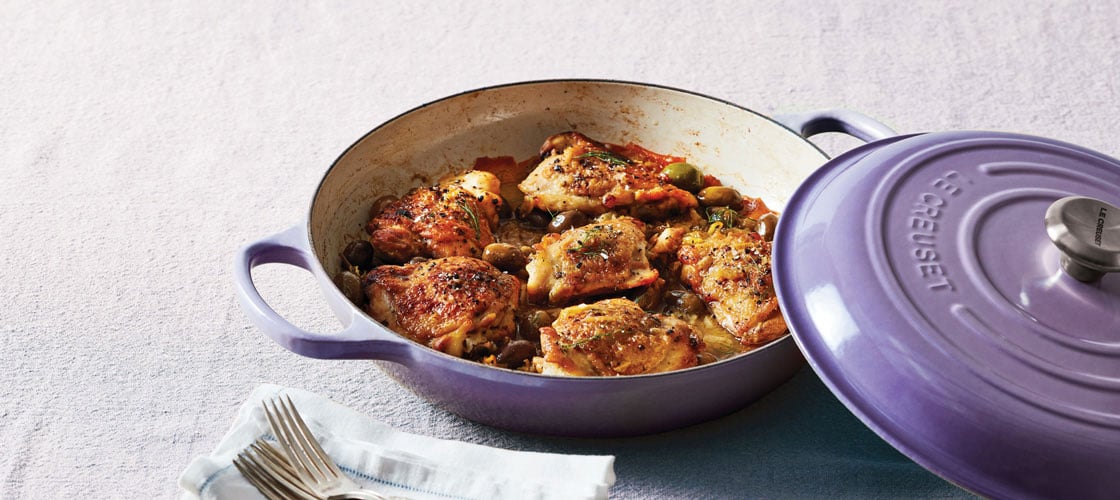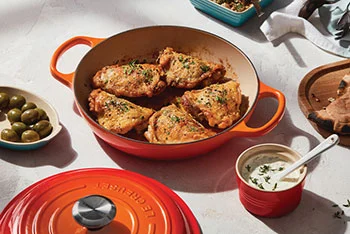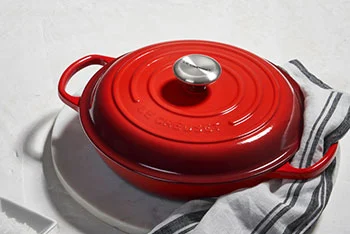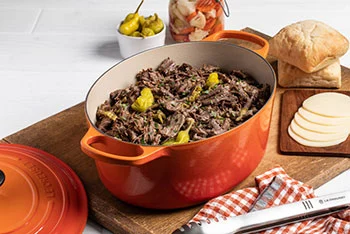Braising is a wonderfully simple cooking method that applies steady, even heat and moisture over a long time to transform tough cuts of meat and vegetables into tender, flavorful dishes. It is typically done in a wide shallow pan appropriately called a braiser.
The best part about braising is that there are only a few easy steps in the process, and it’s also a very forgiving method of cooking. It does require some patience and time to braise, especially for larger cuts of meat, although most of the actual cooking is hands-off. We’ve broken down the steps for how to braise in our test kitchen notes below.

The Technique of Braising
Braising is a simple cooking technique that uses both dry and moist heat and plenty of time to transform tough meats into comforting and rich meals. The best foods for braising are large cuts of meat that have lots of connective tissue, such as short ribs, pork shoulder and chicken thighs. Over time, the slow cooking process will break down the connective tissue resulting in fork-tender food with robust flavor. A bonus is that these cuts of meat tend to be inexpensive, making braising ideal when you’re on a budget or feeding a family.
Note that braising is not just for meats, though. Tough, fibrous vegetables, such as fennel, leeks and root vegetables also benefit from this technique. The gentle heat and flavorful liquid bathes the vegetables and coaxes out their natural caramelized sweetness. Even firm cuts of fish, such as halibut can be braised. Just note that the cooking time won’t be as long.
Some think that braising is similar to making stews, but that is not the case. One of the big differences is the amount of liquid that is used. In braising, you should only use enough liquid to come about halfway up the sides of the food. When making a stew, the meat and vegetables are completely covered by the liquid which is more similar to a soup.

"[A braiser] is the cookware piece I never knew I always wanted."
Chef Noah Galuten
Don’t Panic Pantry
What Pan to Use for Braising
Braising is usually accomplished in a pan called a braiser. This is a wide shallow pan with sloped sides that is particularly optimized for this culinary technique. The wide base is perfect for searing food to lock in moisture and develop flavor, while the sloped sides make it easy to stir and toss. The large cooking surface aids in reducing liquid and stock in the pan to create the thick rich sauce.
Braisers are available in a variety of sizes in our Signature Stainless Steel, Toughened Non-stick PRO, and #1 recommended Enameled Cast Iron cookware collections, and can be used for so much more than just braising though. The multipurpose shape can also take the place of a skillet on the stove top for shallow frying, steaming, stews, casseroles and for serving from oven to table.


Braising Tips from our Kitchen
- Sear - Start by searing your meat and/or vegetables in a little oil, in batches if necessary to ensure there is a little room around the food. You’re looking to develop a golden brown crust on all sides of the meat or vegetables and some delicious brown bits on the bottom of the pan (fond).
- Season - Add your aromatics, such as onions, garlic, vegetables and spices to the pan and sauté until they are softened and slightly brown.
- Deglaze - Add a flavorful liquid like stock, wine, beer, citrus juice or even water to deglaze the pan. Be sure to scrape up all of the brown bits on the bottom of the pan.
- Add liquid - Place the meat and/or vegetables back in the pan. For this step, it’s fine to nestle the food tightly together in the bottom of the braiser. Add more liquid, usually stock at this point, until it comes halfway up the sides of the meat and/or vegetables, and bring the liquid to a simmer.
- Cook low and slow - Cover the braiser, reduce the heat and slowly cook until the meat and/or vegetables are tender and almost falling apart. You can also place the braiser in the oven to finish cooking as well.
- Reduce sauce - When the meat and/or vegetables are done, remove them from the pan and reduce the sauce in the pan until it is slightly thickened.
- Rest - The best part about braises is that the food tastes even better if you let it sit overnight in the fridge to really allow the flavors to deepen.







